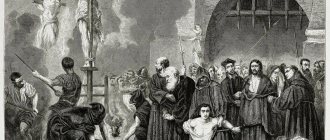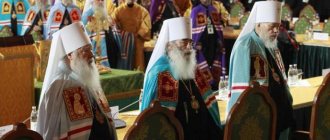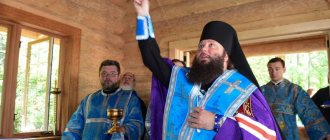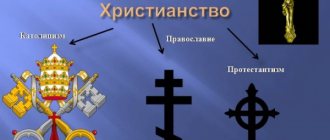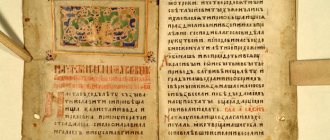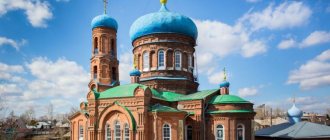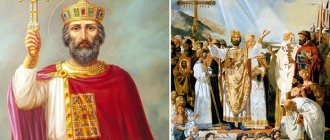It was the spread of Christianity that led to the emergence of heresy: every person who challenged or denied the Catholic Church was called a heretic. Contrary to the belief propagated by churchmen, heretics were rarely Satanists or non-believers. In many cases they had a stronger and stronger faith in God than the clergy themselves. They believed that the classical religious ways were wrong, and so they decided to create their own beliefs.
What it is
A heretic is a person who preaches false teaching, accepting it as truth. Usually the term is used in a religious sense. Often the difference in its interpretations may seem insignificant to outsiders, but it is often a matter of life and death for believers.
Origin of the word
"Heresy" is translated from the Greek αἵρεσις as "direction", "choice" or "current". The term used in Jewish, Islamic or Christian contexts implies different meanings in each. In Judeo-Hellenistic culture, philosophical or religious movements, schools and movements were designated this way. For example, this was the name given to the religious and political parties of the Sadducees and Pharisees. The leader or founder of a heretical movement is a heresiarch, and people who support this teaching are heretics.
The meaning of the concept according to the Bible
In the New Testament Apostolic Epistles, the concept takes on a different semantic connotation: in the scriptures it is rarely mentioned and in most cases means belonging to sects, opposition to correct dogma, denial of the truth of Divine Revelation.
Biblical meanings of the word heresy:
- A statement, concept, or teaching that is contrary to the teachings of the Church.
- Misconception regarding Orthodox dogmas, supported by conscious persistent opposition to the Truth.
- Deliberate distortion of Orthodox dogma.
Modern definition
In a broad sense, it is any opinion that contradicts generally accepted customs or beliefs. The term is also used to refer to a person who promotes views that are categorically opposed to generally accepted ideas, and not only to denote a violation in the interpretation of religious teachings.
The original meaning of the definition in history is an error in matters of faith, recorded in someone’s teaching or opinion that appeared within the Church. In philosophy, teachings that deny faith in Christ, in whom perfect man and perfect God are inseparably united (according to V. Solovyov), are called heretical.
Where do heresies come from?
The Arian dispute, which split the Church in the 4th century, raged for almost a hundred years, and its consequences were felt even longer. It all started with the arrival of many educated people in the Church, who were keenly interested in problems that had previously worried few people. And different understandings of the trinity of the Divine appeared.
For example, the heretic Savelius of Ptomaleid taught that the Trinity is one God with three faces, which He changes, like masks change in the Greek theater, and appears to humanity in one form or another.
Another heresiarch, Paul of Samosat, argued exactly the opposite. He believed that there is only one true God - God the Father. But God the Son and God the Holy Spirit are not completely divine entities. And his views took root for a long time in the East, especially in Syria. The presbyter of the Alexandrian Church Arius also adhered to them. He was, of course, a bright, talented and so popular man that the Bishop of Alexandria Achilles, dying, even predicted him to be his successor. True, he never became a bishop - he was not chosen.
Unholy Arius.
What did Arius think about God? That there is an almighty God the Father, who is simultaneously present in all forms, in all times... He has always been. But was there always God the Son? Arius strongly doubted this. After all, the Son always appears after the Father. Consequently, He was created by the Father and, like all other creations, has a created nature. But the Father’s nature is fundamentally different—eternal, Divine. That is, Arius denied Jesus full Divinity. For which he was condemned in 318 by Bishop Alexander of Alexandria.
Who are heretics
This is the name given to people who deliberately deviate from religious teachings considered true.
Historical meaning
Initially, Gnostics were called this, although it is hardly legitimate to consider Gnosticism a Christian teaching. Simon Magus is considered the first heretic (Acts 8:9).
The following heretical teachings belong to the early period:
- Ebioniteism;
- Kerinthianism;
- Christmas tree;
- docetism;
- Manichaeism;
- Montanism;
- chiliasm.
The historical significance of the appearance of heretics and schismatics is that they called the church to increased intellectual activity, thereby prompting it to more accurately formulate and disclose its teaching in more detail. The ultimate goal was systematization, which was done for the Eastern Church back in the 8th century by John of Damascus.
The essence of doctrine and faith
In the Middle Ages, heretical teachings were common, and their essence was quite diverse.
The main directions of the teachings and beliefs of the heretics:
- Denial of the simultaneous presence of the Divine and human principles in the Savior.
- The world is an arena for the struggle between the forces of good and evil.
- Emphasis on broad social reforms.
- A call for equality in property or the complete abolition of all property.
- Prediction of the imminent arrival of the Kingdom of God on earth.
- Denial of the Sacrament of Communion.
- Conducting baptism with one laying on of hands.
- Denial of the cult of the Crucifixion.
The Cathars and Waldenses were the most influential doctrines in the X-XIII centuries. The French merchant Pierre Waldo became the founder of the Waldensians. He argued that salvation can only be achieved through serving Jesus Christ and following his teachings, and not through the church. Waldo believed that the church was corrupted by wealth and deprived of its original holiness.
The Cathars (from the Greek Cathar - “pure”) convinced people that the church was the creation of the devil, and therefore it was necessary to create a new one. The city of Albi (southern France) became the center of the doctrine, which is why the movement itself was called Albigensian. It enjoyed the favor of the Count of Toulouse and was extremely influential.
Ancient heretical texts were usually destroyed, so information about the teachings can be gleaned from their denouncers:
- St. Irenaeus of Lyon;
- St. Hippolytus of Rome;
- Tertullian;
- Origen;
- St. Cyprian of Carthage;
- St. Epiphany of Cyprus;
- Clement of Alexandria;
- Eusevia Pamphilus;
- bl. Theodorite;
- bl. Augustine;
- Euphemia Zigabena.
Reasons for appearance
There were many heretics, but despite all the differences in their teachings, they were united by dissatisfaction with the existing order. People tried to understand the reasons for the injustice reigning in society. They looked for answers to their questions in the Bible, but what they found was not at all what the priests preached. It turned out that the holy fathers were hiding the true meaning of Holy Scripture from believers. Therefore, the entire church serves the devil and not God.
Catholic priests imposed on people complexes of insignificance and inferiority before God: for this purpose, the construction of famous cathedrals began, impressive in majesty and grandeur. The priests zealously preached: the only way to receive divine grace is to live in poverty. The ministers themselves bathed in luxury, collected tithes from the population and performed expensive rituals, and the church had unlimited power and countless possessions.
The appearance of the abbots and bishops, dressed in luxurious clothes and well-fed, had nothing in common with the lifestyle of Christ and the apostles. Heretics sought to revive evangelical simplicity and poverty and demanded that the clergy renounce wealth and land holdings. They dressed in rags, distributed their property to the poor, traveled and preached, and ate alms.
From the point of view of the common man, the heretics were much more like the apostles than the “successor of the Apostle Peter.”
Historical reference
In the space of history, from the beginning of the emergence of churches to the present day, a string of countless heretical movements, ancient and new, continuously stretches. From the repetition of old conditions, non-church modified teachings about Christian dogmas arise. The Church refutes them, fights with them and wins, and excommunicates the heretics after unsuccessful attempts to convert them to their faith.
In the interests of peace, “protecting its mother, the holy church,” the Greco-Roman state subjects heretics to criminal prosecution. Western European medieval Catholic states are even more fanatical: they burn them, often refusing to distinguish between real heretics and people of science who have nothing to do with church doctrines, but should be dependent on their dogma. This example is followed by ancient pre-Petrine and partly post-Petrine Rus'.
At all times, the sources of heretical movements have usually been:
- The reluctance of pagans, Jews and followers of Eastern dualism, having adopted Christianity, to finally part with their previous religious worldview. They tried to combine new Christian doctrines with their old ones into a single whole.
- The desire of stronger minds to put the teaching given as revealed by God on the same level with the philosophical worldview of the ancient world. These teachers had a good intention, but by the very nature of things it was impossible to fulfill. Everything led to rationalism. This was the most powerful teaching of heretics of all times - Arianism with all its branches.
- Original theology of teachers of church tradition and the general voice of the Ecumenical Council. With self-confidence and conceit, the absence of legal principles led to a violation of the normal composition of the teachings of the church.
This video examines the origins of heretical teachings using the example of Arianism.
Modern heretics
In modern times, the term is used to refer to representatives of any religious movement that may cause a believer to break away from orthodoxy or conventional wisdom. Most modern representatives of the movement preach views that contradict the contents of the Bible.
Modern heretical movements (XX century - to the present) and their essence:
- Pentecostalism, USA. Heresiarch - Charles Fox Parham. They attach special importance to the baptism of the Holy Spirit and understand it as a special spiritual experience, identical to the emotional state of the apostles on the fiftieth day after the resurrection of Jesus Christ. We are convinced that the power received as a result of baptism is manifested in the ability to speak in other tongues.
- Anthroposophical Society (Waldorf Schools), Switzerland. Founder: Rudolf Steiner. Through freely chosen meditation exercises, everyone can develop a sense of the spiritual world. Such training should help the individual become more creative, moral and free; become a person who is motivated solely by love.
- Roerich movement (Agni Yoga, Spiritual Center named after Sergius of Radonezh, Living Ethics), USSR. Heresiarchs - Nicholas Roerich, Helena Roerich. They believe that many religions contradict each other, and their followers have long abandoned the main occult truths, leaving behind false ones.
- Church of the Last Testament, Russia. Founder: Sergei Torop (“Vissarion”). It is a synthesis of Abrahamic religions, Buddhism, Hinduism, the atheistic teachings of Karl Marx, anti-trinitarianism, apocalypticism and much more.
- Ivanovo, USSR. Heresiarch - Porfiry Ivanov. The cult of improving the body, unity with nature.
- Rodnoverie, Russia. There is no single leader. They proclaim the goal of reviving paganism, pre-Christian and Slavic rituals.
- Mother of God Center, Russia. Founder: John Bereslavsky. Syncretic movement includes some Catholic dogmas, sophiology, Judeo-Christian and Gnostic views. The goal is to create a totalitarian theocratic state “New Holy Rus'” on the territory of the former USSR.
- White Brotherhood, USSR. Heresiarch - Yuri Krivonogov, Maria Tsvigun. The leaders of the movement consider themselves new hypostases of the Triune God and preach their doctrines.
- International Society for Krishna Consciousness, USA. Founder: Bhaktivedanta Swami Prabhupada. A conditional group of Hindu movements of Vaishnavism. They consider Krishna to be the only true god, and all others as his avatars.
- Karma Kagyu, Denmark. Heresiarch - Ole Nydahl. “New Buddhism” combines traditional Tibetan culture with European culture.
- Charismatic movement, USA. Director: Dennis Bennett. The movement proclaims that the gifts of the Holy Spirit (healing, prophecy) are being manifested in its communities.
- Scientology, USA. Heresiarch - Ron Hubbard. The cult is aimed at people striving for success and career. It is a synthesis of Buddhism, Gnosticism, Judaism, Taoism, the philosophy of Nietzsche and the psychoanalysis of Sigmund Freud.
- Anastasia, Russia. Founder: Vladimir Megre. They revere the mythical woman Anastasia, a character in Maigret’s books, who has paranormal and occult powers.
- New Age, USA. Heresiarch - Alice Bailey. They preach that everything in the world is divine and has unlimited potential.
“Everything is full of people talking about the incomprehensible”
Arius fled from Alexandria and turned for support to his classmates, among whom were Eusebius of Caesarea, the father of church historiography, and Eusebius of Nicomedia, the bishop of one of the imperial residences.
The dispute flared up in earnest. And for Emperor Constantine, when he decided to rely on Christianity, it was fundamentally important to preserve the unity of the Christians themselves. At first he tried to convince Arius and Alexander to make peace and not raise this dogmatic dispute at all. But in the end it had to be sorted out by convening the First Ecumenical Council in Nicaea in 325, at which the majority of bishops condemned the teachings of Arius and accepted the Creed, in which God the Son was recognized as Consubstantial and Co-Eternal with the Father.
Arius and several of his followers went into exile. But there Arius did not remain silent for long. Having settled in Nicomedia, he set out his teachings in the Thalia, a book intended for common people. As a result, theological issues became the subject of street gossip. About how the supporters of Arius preached their ideas, Athanasius the Great wrote:
“To this day, not a small number of Arians catch youths at the marketplaces and ask them questions not from the Divine scriptures, but as if pouring out from the abundance of their hearts... Everything is full of people talking about the incomprehensible - streets, markets, crossroads. I ask how many obols must be paid, and they philosophize about the born and the unborn. If you want to know the price of bread, they answer: “The Father is greater than the Son.” You ask if the bathhouse is ready, they say: “The son came from nothing.”
|
The fight of the Catholic Church against heretics
Heretics preached the “truth,” thereby undermining the foundations of the power of the Catholic Church, so they were persecuted.
Reasons for development
The emergence and development of sectarian teachings is usually associated with ideological and social changes that appeared in the life of society during the period of persecution. The poorest segments of the population sought equality and reconciliation in the new religion, therefore the gradual enrichment of the clergy, apostasy during the period of persecution and the strengthening of the administrative principle caused condemnation from ordinary believers. The ideals of simple and modest early Christian life continued to live in the poorest segments of the population.
The reasons for the emergence and spread of the ideas of heretics, with whom the Catholic Church waged a long and bloody struggle:
- contradictory moods of the masses;
- various interpretations of Christian teaching;
- general dissatisfaction with the well-fed life of the higher clergy.
Persecution of heretics
According to medieval chronicles and annals, a heretic was a person who denied the authority and teachings of the Councils. The first mention of the church’s struggle with such people dates back to 1022: in Orleans, all dissidents were sentenced to be burned. The first victims of the fires were educated confessors, justifying their dissent with the help of theology.
Executions in Orleans opened the way to the most brutal repressions; bonfires were burned in Toulouse and Aquitaine. Entire communities of other faiths appeared before bishops, appearing with the Bible in their hands before church courts. By quoting from the Holy Scriptures they tried to prove the correctness of the doctrines they preached. The condemned were sent to the stake in their entirety, not sparing children and the elderly. The burning is the most striking example of how the Catholic Church fought against heretics.
In the 12th century, fires broke out in the Rhineland. There were so many condemned that the monk Everwin de Steinfeld asked for help from the Cistercian monk Bernard, who had a reputation as a cruel persecutor of non-believers. After large-scale raids and pogroms, bonfires were lit in Cologne. Court verdicts were no longer full of unfounded accusations of licentiousness and witchcraft, but contained clear points of disagreement between sectarians and orthodox church concepts.
The convicted and sentenced “apostles of Satan” accepted their death so steadfastly that they caused murmurs and concern from the crowd present at the burning.
At that time, the lands of Southern Europe were considered the main centers of heretical movements. Communities were built in the image of Catholic churches, but leadership positions were also given to women. Heretics in the Middle Ages were called "good men and women." Later researchers began to call them Cathars.
It is known that heretics had their own church institutions, held their own councils, and attracted new adherents to their ranks. France and Germany destroyed dissent in the bud, but in Italy and Languedoc the Cathars strengthened and expanded their influence. At that time, many noble families accepted the new faith, provided shelter and food to their persecuted coreligionists, and spread the teachings they preached.
Inquisition and public execution
Despite the despotic policies of the church, more and more people appeared among the townspeople and peasants who questioned the fidelity of its teachings. They accused the clergy of idleness and excessive waste of money. The Catholic clergy instantly reacted to religious rebellion, responding with severe repressions that troubled the whole of Europe for several centuries.
To combat heretics, the Inquisition was created, which is a secret church court that, through the practice of anonymous reports, dealt with the “messengers of the devil on earth.” The trial lacked an investigative procedure; it was accompanied by prolonged and cruel torture and ended with the death penalty of the person.
Often, prosecutors and judges did not even know the names of those convicted and designated them “accused number one, number two...”. The medieval Inquisition delegated to secular authorities the power to execute non-believers, but always controlled the execution of the sentence. The death penalty was carried out by public burning. This punishment was widespread.
At the initial stage, the victims were people who did not agree with the classical teachings of the church. Over time, the categories of apostates increased exponentially. Attractive women and girls were accused of vicious relationships with the devil and witchcraft. Babies born with physical disabilities were considered children of Satan. An inevitable death fate awaited them all.
The families of heretics were ruined, their property was divided in half between the clergy and the state treasury. Scientific figures whose views radically diverged from the teachings of the church also became victims of the inquisition processes. The famous astronomer Galileo Galilei was able to avoid death at the stake only after he publicly renounced the teachings of Copernicus.
It is estimated that the fire of the Holy Inquisition claimed the lives of more than 12 million Europeans, 98% of whom were innocent.
How the struggle “for the purity of faith” can lead to a schism
From these words it is clear how deeply the Arian heresy worried all Christians at that time. This is understandable - the whole people felt that the dispute was not about an abstract theoretical question, but about the very essence of faith.
Most local bishops were looking for some kind of compromise. And the emperor himself, at the end of his reign, was inclined to soften the wording of the Council of Nicea for the sake of unifying the divided Church. He even sent into exile the most ardent champions of the Nicene symbol, such as Bishop Athanasius of Alexandria. And on his deathbed he was baptized by one of the leaders of the Arians, Eusebius of Nicomedia.
How the saints fought for the Church. Mini-project "Fomas"
It was under Zeno that the Western Roman Empire was abolished and Byzantium remained the only successor to Rome. But Rome was greatly weakened: back in 429, Vandals from Spain invaded its African provinces and took Carthage in 439, and in 455 they captured and plundered the Eternal City itself.
But in the conquered territories, especially in Africa, the conquerors, of whom there were not so many, and they had nowhere to expect an influx of new tribesmen, were very afraid of assimilation with the local population. And Roman Africa, the second region of the empire in terms of development after Italy, by that time was almost completely Christian, and mostly orthodox Christian, which significantly complicated its development for the Vandals.
Therefore, they chose the win-win tactic of “divide and conquer,” pitting the Arians and Nicenes against each other. But the orthodox local population, which at first accepted the Vandals as deliverers from the oppression of the Romans, quickly lost interest in them due to religious persecution.
